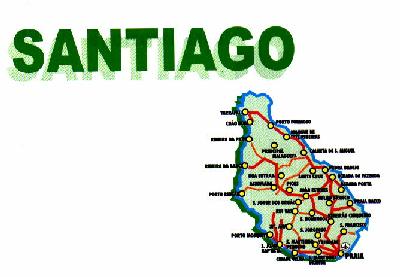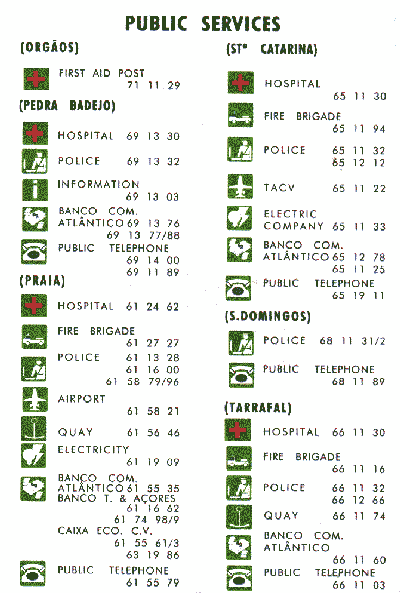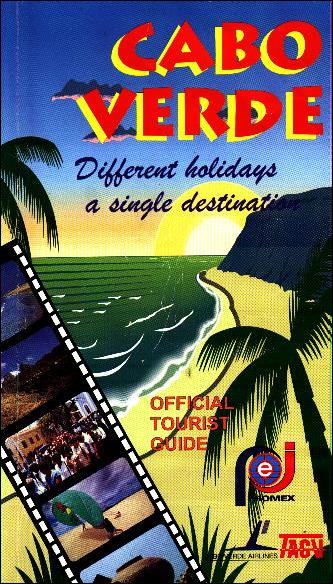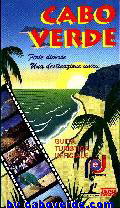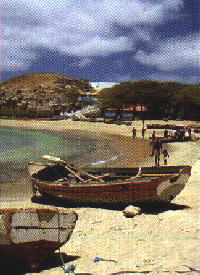
Location
In the middle of the leeward group of islands with a surface area of 991 Km2, SANTIAGO is the biggest island in the Archipelago. In the north/south direction, its longest point is 55 Km and from
east to west, 29 Km.
Of volcanic origin, the highest point of its mountainous peaks is called ANTÓNIO, with an altitude of 1392 m.
The deep and beautiful valleys, the result of hundreds of years of erosion, after good agricultural conditions and the view of these regions from above is truly picturesque.
There is a great contrast between the vegetation and the mild and humid climate of the higher regions and that of some lower regions, which are very dry and arid.
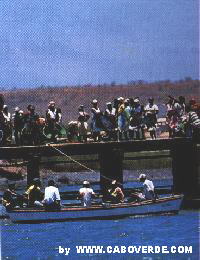
History
SANTIAGO was the first island to be populated after the Portuguese discovery of Cape Verde in the XV century.
The economy of the island was developed mainly through the use of African slave labour. As a result it became a commercial trading post with the African Continent and naturally assimilated more of the African influence than the rest of the islands.
Pirate attacks were frequent on the capital town of RIBEIRA GRANDE, the name given to CIDADE VELHA at that time. In 1583, it was also attacked by forces supporting the Prior of Crato, in the battle for the succession to the throne of Portugal and the French pirate J.Cassard finally devasted the town in 1712. It was from this point on that PRAIA assumed predominance and today remains the capital of the Republic.
Agriculture and fishing are still the main industries of SANTIAGO.
The island is full of beautiful scenery, charming beaches and living examples of its historical past.
Cultural Events
Religious and other Festivals
GAMBOA FESTIVAL -
Musical dernonstration in Cidade da Praia, around the festivities of the Municipality Day, in May.
POPULAR SAINTS -
June and July are the months when the celebrations of the Popular Saints take place. These celebrations are given the name of Tabanca.
'Tabanca' is where a number of groups from various islands meet in the capital of PRAIA. There are colourful processions led by the "King" and "Queen" accompanied by music from conch shells and drums.
The "daughters of the Saint" are the beatiful island girls who file past swaying their hips in time to the rhythm.
N° SR° DA GRAÇA -
The festival of Nossa Senhora da Graça (Our Lady of Grace), the first patron saint of Praia, is celebrated on the 15th of August.
Handicraft
Clay pots and other kitchen utensils made by the women of FONTELIMA are typical examples of the handicraft of this island.
Basket-weaving and articles made from coconut shells are also other interesting examples.
The beautiful woven cloths, which at one time were one of the articles exported from Cape Verde, can still be found, but in much smaller quantities.
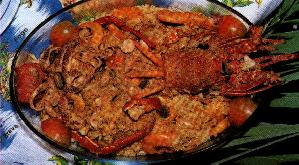
Food and Drink
The food is rich and varied and the base of most dishes is deliciously fresh fish and shellfish.
'Cachupa', as mentioned previously, is the most typical dish in Cape Verde and can be found on all the islands. Each island, however, adds to it its own special touch.
Coconut milk is used in the confection of a great number of sweet meats.
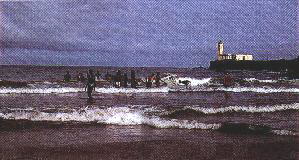
Entertainment and Sports
Nautical sports, mountaineering and long walks are what this island has to offer its visitors, apart from, of course, the beautiful unpolluted scenery. Praia has an animated night-life, with discotheques where local bands often play.

Places to Visit
Cidade da Praia
The City of PRAIA, originally called Praia de Sta Maria, was built on a basaltic platform overlooking the bay and this area is known as the "Plateau". A walk through this lovely town, stopping for a coffee at one of the pleasant esplanades or just relaxing in the gardens is an excellent way to spend an afternoon. It is also fascinating to visit the local markets the real real commercial centres of the tropics-and come in contact with the local habits and customs. From Praia, one can also see the islet of Sta Maria. Prainha is the name given to the area right next to the sea. The Hotel Praia Mar is here and its small beach is a popular and very interesting meeting place. Another delightful beach is Quebra Canela.
Cidade Velha (Ribeira Grande)
Cidade Velha was the first capital of the Cape Verdean islands and is the birthplace of Cape Verdean culture. There are still a number of ruins testifying to its sumptuous past. The fortress of S.Filipe for example is still fairly well preserved.
Tarrafal
A visit to TARRAFAL should be done in stages:
The first step is PRAIA/ASSOMADA. The scenery along the route is magnificent and a stop at SÃO JORGE DE ORGAOS is a must to see the streets full of bougainvillae.
Further on towards ASSOMADA is the highest peak on the island, called the Peak of António. In ASSOMADA itself, houses are very aftractive and 50 it the local market.
From ASSOMADA, the road goes to Boa Entrada and one can admire a magnificent tree here of extraordinary proportions with the name of "Pei de Polom". On the way to RIBEIRA da BARCA there is a deep canyon which is also worth seeing.
In RIBEIRA da BARCA, take a boat trip to the grotto called "Águas Bella" which is very unusual inasmuch as there is a beach in the interior. TARRAFAL is next on the route. Here there are two points of interest, the beautiful beach and the old political prison located 3 Km away from the town centre.
On the way back to Praia, the road passes by Pedro Badejo on the coast where the limpid blue of the lagoons and the rich green of the luxurious tropical vegetation blend together beautifully.
